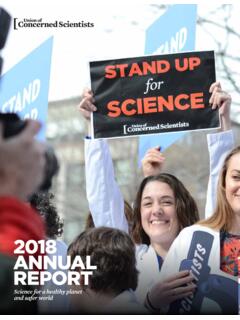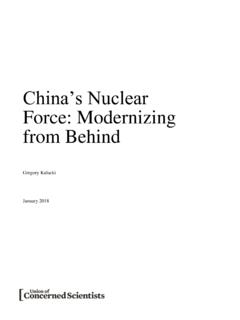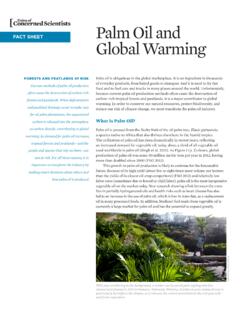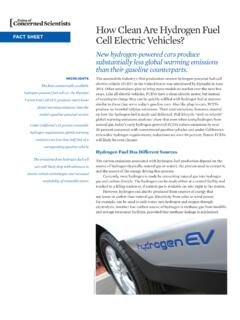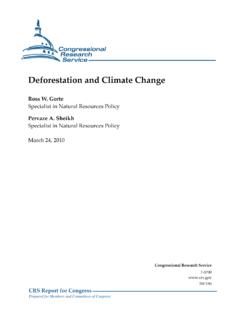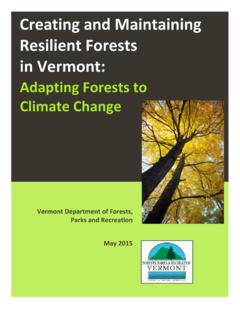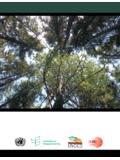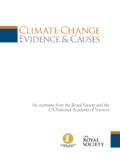Transcription of Cattle, Cleared Forests, and Climate Change
1 Don AnairAmine MahmassaniJuly 2013 cattle , Cleared Forests, and Climate ChangeScoring America s Top Brands on Their Deforestation-Free Beef Commitments and Practices2union of concerned scientistsCover photo: CIFOR/Creative Commons (Flickr)Each year, tropical forests are destroyed to clear land that is ultimately used for beef production, making beef the largest driver of tropical deforestation globally. South America s forests are ground zero for beef-driven deforestation. Here, ranchers clear tropical forests and other ecosystems such as native grasslands and woodlands to create pastures, in the process releasing enormous amounts of heat-trapping gases, destroying the habitat of wildlife such as jaguars and sloths, and encroaching on the homes of vulnerable indige-nous peoples.
2 The Union of Concerned Scientists (UCS) evaluated 13 consumer goods companies in the fast food, retail, and food manufacturing sectors that have the power to help stop this destruction. They each source beef from South America and should work with their South American suppliers to help Change practices in order to ensure that the beef in their products is not causing deforestation. UCS has found that even companies taking action on this issue have major gaps in their policies and practices that mean they may be profiting from selling deforestation-risk beef, or beef produced with-out safeguards that would prevent deforestation. Nine of the 13 companies we scored lack any public policies or plans detailing how they intend to completely eliminate deforestation associated with their beef purchases.
3 Of these nine, four did not receive a single point on our score-card: Burger King, ConAgra, Kroger, and Pizza Hut. Subway earned only five points. Four others Hormel, Jack Link s, Safeway, and Wendy s source their beef from suppliers implementing some practices to prevent deforestation in South America, but these companies should work with their suppliers to address the limitations of these practices and also publicly demonstrate that they have strong deforestation-free policies and action plans of their own in place. Nestl has a deforestation-free beef commitment but needs to make more progress implementing companies making the most progress in adopting and implementing deforestation-free beef commitments and practices are Mars, McDonald s, and Walmart, but they also have much room for improvement.
4 First, not all of their supplying ranches are traced and monitored for deforestation, which means every company we scored cannot guarantee that its beef is truly deforestation-free. Second, each of these companies with a commitment focuses implementation only on the Brazilian Amazon, even though many other ecosys-tems are also at risk. All companies also lack adequate trans-parency, which leaves consumers and investors in the dark about whether companies are carefully monitoring and evaluating their supply chains for tropical deforestation. Beef can be produced without deforestation. The compa-nies scored in this report have the power to help save forests and our Climate . Thanks to consumer demand, government action, and nongovernmental organization (NGO) advocacy, some companies and their suppliers have taken steps to ad-dress this risk, but all the companies scored lack sufficient policies and practices to ensure the beef in their products is not connected to tropical deforestation in South America.
5 Consumers can help save forests by demanding that these 13 companies take deforestation off their menus and out of their ingredients by working with their suppliers to imple-ment verified deforestation-free practices. When consumers speak, companies listen and Beef ?Beef production is the number-one driver of tropical defor-estation in South America and worldwide (De Sy et al. 2015; Henders, Persson, and Kastner 2015). Analysis of nations with high rates of tropical deforestation has shown that the amount of deforestation fueled by beef production is more than twice as large as the combined amount resulting from the production of soy, palm oil, and wood products the next three largest drivers of tropical deforestation (Henders, Persson, and Kast-ner 2015).
6 In South America, beef production was responsible for 71 percent of total deforestation between 1990 and 2005 (De Sy et al. 2015). cattle are raised primarily for meat and dairy products, but the industry also produces a number of other cattle products, such as fats, leather, and gelatin, which can be found in everything from lotion to , Cleared Forests, and Climate ChangeSoy, the second largest driver of deforestation, also heavi-ly affects the South American landscape. Every year, around half a million hectares are deforested for soy in major soy- producing tropical nations (Henders, Persson, and Kastner 2015). The majority of soy is used as animal feed; around 70 to 75 percent of the world s soy ends up as feed for cows, chickens, pigs, and farmed fish (Brack, Glover, and Wellesley 2016).
7 Thus, soy is also connected to South America s largest meatpackers, which use large amounts of animal feed in their beef, poultry, and pork operations. While some progress has been made in tackling deforestation resulting from production of these two commodities, forests are still disappearing to make room for soy and pastureland expansion. forest destruction leads to the release of massive amounts of heat-trapping gases and the subsequent effects on Climate , along with reduced biodiversity. When forests are cut down or set on fire to make way for agriculture, the vegeta-tion decomposes or burns, releasing carbon into the atmo-sphere. In total, around 10 percent of annual global carbon dioxide emissions result from tropical deforestation (UCS 2013).
8 forest destruction also leads to habitat loss for a vari-ety of species. Tropical forests contain some two-thirds of the planet s land species (Gardner et al. 2009), and forests in South America provide habitat for species such as jaguars, harpy eagles, and sloths. In addition, tropical forests help clean the air and water and regulate local temperatures and precipitation. If deforestation continues at current rates, regional Climate changes such as reduced precipitation could lower pasture productivity in the Brazilian Amazon up to 33 percent by 2050 (Oliveira et al. 2013). Thus, deforestation can be a lose-lose situation for all of us who rely on a stable Climate and for the ranchers whose livelihoods depend on sufficiently productive land.
9 Around one billion people worldwide rely on forests to some extent for their livelihoods. Deforestation for pasture-land expansion can therefore harm local communities and indigenous peoples by depriving them of this resource (Chao forest destruction leads to the release of massive amounts of heat-trapping gases and the subsequent effects on Climate , along with reduced are also Cleared to produce soybeans, which are used as animal feed in poultry, pork, and beef operations. Rhett of concerned scientists2012). Insecure land rights have also led to land grabbing, deforestation, and conflict over land ownership (Chao 2012; Puppim de Oliveira 2008). Protecting the rights of local communities and indigenous peoples can have positive outcomes for forests.
10 The rate of deforestation is 7 to 11 times lower in the Brazilian Amazon in protected areas and on lands where indigenous peoples hold effective land owner-ship than in other regions (Ricketts et al. 2010). These areas create a crucial barrier, backed by force of law, which can help alleviate agriculture-driven deforestation occurring in surrounding areas. This report discusses the problem of beef as a driver of tropical deforestation and recommends solutions. Beef can be produced in several different ways, each with its own im-plications for animal welfare, public health, workers, local communities, and the environment. There are a number of reasons consumers might consider reducing their consump-tion of beef. Studies have shown that overconsumption of beef leads to an increased chance of developing cardiovascu-lar disease, certain cancers, and other health conditions (Sinha et al.)

